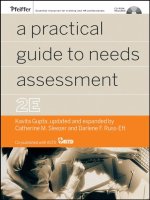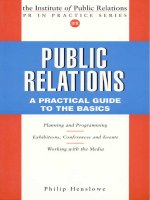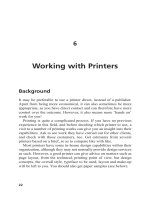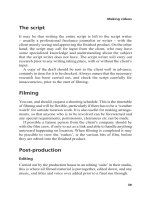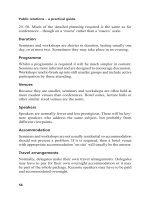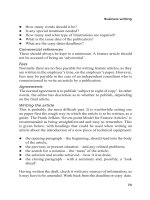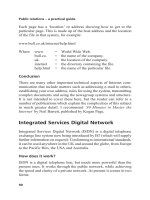A practical guide to needs assessment pot
Bạn đang xem bản rút gọn của tài liệu. Xem và tải ngay bản đầy đủ của tài liệu tại đây (3.28 MB, 353 trang )
About This Book
Why is this topic important?
Most experts agree that human learning, training, and performance-improvement ini-
tiatives should begin with a needs assessment that examines the relevant people-
related problems and performance improvement opportunities. Human resource
development and performance improvement practitioners rely on a needs assessment
to develop and implement practical solutions for individuals, work groups, organiza-
tions, communities, and nations.
What can you achieve with this book?
This how-to handbook is perfect for anyone who seeks a systematic approach to assess-
ing needs, including those who are responsible for introducing a training or devel-
opment program; assessing the development needs of a workforce; improving
individual, group, organization, or interorganization performance in the workplace; or
providing community, national, and international development interventions.
You will read about real-life cases and tips, and about needs assessment thought
leaders and their ideas and models. You will also get a treasury of tools including work-
sheets, ready-to-use forms, and templates for planning a course of action. The accom-
panying CD-ROM, which is packed with job aids, will allow you to customize the tools
for your own use.
How is this book organized?
Part One begins with a bird’s-eye view of needs assessment. Use the information on
what needs assessment is, on the well-known models and theories of needs assess
-
ment, and on the how-tos of data collection and analysis to frame your needs assess-
ment and to enhance your credibility with stakeholders and clients.
Part Two describes four approaches to needs assessment that can contribute greatly
to success. A chapter describes each approach, including when to use the approach, and
its benefits, drawbacks, and critical success factor
s. Where appropriate, time-saving tips
ffirs.qxd 11/2/06 11:09 AM Page i
are offered. Key steps are explained, and corresponding forms and worksheets in the
Toolkit section are referenced.
Part Three describes strategies for managing a needs assessment. It includes ideas
for writing proposals and reporting, strategies for dealing with the ethical issues that
can arise when implementing a needs assessment, and answers to frequently asked
questions.
Part Four contains the Needs Assessment Toolkit. It includes various templates that
can be replicated and used as they are or customized by making changes on the CD-
ROM included with this book.
ffirs.qxd 11/2/06 11:09 AM Page ii
About Pfeiffer
Pfeiffer serves the professional development and hands-on resource needs of
training and human resource practitioners and gives them products to do their
jobs better. We deliver proven ideas and solutions from experts in HR develop-
ment and HR management, and we offer effective and customizable tools to
improve workplace performance. From novice to seasoned professional, Pfeif-
fer is the source you can trust to make yourself and your organization more
successful.
Essential Knowledge Pfeiffer produces insightful, practical, and
comprehensive materials on topics that matter the most to training
and HR professionals. Our Essential Knowledge resources translate the expertise
of seasoned professionals into practical, how-to guidance on critical workplace
issues and problems. These resources are supported by case studies, worksheets,
and job aids and are frequently supplemented with CD-ROMs, websites, and
other means of making the content easier to read, understand, and use.
Essential Tools Pfeiffer’s Essential Tools resources save time and
expense by offering proven, ready-to-use materials—including exercises,
activities, games, instruments, and assessments—for use during a training
or team-learning event. These resources are frequently offered in looseleaf or CD-
ROM format to facilitate copying and customization of the material.
Pfeiffer also recognizes the remarkable power of new technologies in
expanding the reach and effectiveness of training. While e-hype has often cre-
ated whizbang solutions in search of a problem, we are dedicated to bringing
convenience and enhancements to proven training solutions. All our e-tools
comply with rigor
ous functionality standar
ds. The most appr
opriate tech
nol
-
ogy wrapped around essential content yields the perfect solution for today’s on-
the-go tr
ainers and human resource professionals.
Essential resources for training and HR professionals
www.pfeiffer.com
ffirs.qxd 11/2/06 11:09 AM Page iii
ffirs.qxd 11/2/06 11:09 AM Page iv
A
Practical Guide to
Needs Assessment
Second Edition
Kavita Gupta
updated and expanded by
Catherine M. Sleezer
and Darlene F. Russ-Eft
ffirs.qxd 11/2/06 11:09 AM Page v
Copyright © 2007 by John Wiley & Sons, Inc.
Published by Pfeiffer
A
n Imprint of Wiley
9
89 Market Street, San Francisco, CA 94103-1741
www.pfeiffer.com
N
o part of this publication may be reproduced, stored in a retrieval system, or transmitted in any form or by any means,
e
lectronic, mechanical, photocopying, recording, scanning, or otherwise, except as permitted under Section 107 or 108 of
the 1976 United States Copyright Act, without either the prior written permission of the publisher, or authorization
through payment of the appropriate per-copy fee to the Copyright Clearance Center, Inc., 222 Rosewood Drive, Danvers,
M
A 01923, 978-750-8400, fax 978-646-8600, or on the Web at www.copyright.com. Requests to the publisher for
p
ermission should be addressed to the Permissions Department, John Wiley & Sons, Inc., 111 River Street, Hoboken, NJ
07030, 201-748-6011, fax 201-748-6008, or online at />L
imit of Liability/Disclaimer of Warranty: While the publisher and author have used their best efforts in preparing this
b
ook, they make no representations or warranties with respect to the accuracy or completeness of the contents of this book
and specifically disclaim any implied warranties of merchantability or fitness for a particular purpose. No warranty may be
created or extended by sales representatives or written sales materials. The advice and strategies contained herein may not be
s
uitable for your situation. You should consult with a professional where appropriate. Neither the publisher nor author shall
be liable for any loss of profit or any other commercial damages, including but not limited to special, incidental,
c
onsequential, or other damages.
T
he materials on the accompanying CD-ROM are
designed for use in a group setting and may be customize
d and
r
eproduced for educational/training purposes. The reproducible pages are designated by the appearance of the following
copyright notice at the foot of each page:
This notice must appear on all reproductions as printed.
This free permission is restricted to limited customization of the CD-ROM materials for your organization and the paper
reproduction of the materials for educational/training events. It does not allow for systematic or large-scale reproduction,
distribution (more than 100 copies per page, per year), transmission, electronic reproduction or inclusion in any
publications offered for sale or used for commercial purposes—none of which may be done without prior written
permission of the Publisher.
Readers should be aware that Internet Web sites offered as citations and/or sources for further information may have
changed or disappeared between the time this was written and when it is read.
For additional copies/bulk purchases of this book in the U.S. please contact 800-274-4434.
Pfeiffer books and products are available through most bookstores. To contact Pfeiffer directly call our Customer Care
Department within the U.S. at 800-274-4434, outside the U.S. at 317-572-3985, fax 317-572-4002, or visit
www.pfeiffer.com.
Pfeiffer also publishes its books in a variety of electronic formats. Some content that appears in print may not be available in
electronic books.
Library of Congress Cataloging-in-Publication Data
Gupta, Kavita, date.
A practical guide to needs assessment / Kavita Gupta; updated and expanded by Catherine M. Sleezer and
Darlene F. Russ-Eft.—2nd ed.
p
. cm.
Includes bibliographical references and index.
ISBN-13: 978-0-7879-8272-0 (cloth)
ISBN-10: 0-7879-8272-5 (cloth)
1. Training needs—Evaluation. 2. Needs assessment. I. Sleezer, Catherine. II. Russ-Eft, Darlene F. III. Title.
HF5549.5.T7G87 2007
658.3’124—dc22 2006030501
A
cquiring E
ditor: M
atthe
w D
avis
Director of Development: Kathleen Dolan Davies
Production Editor: Nina Kreiden Editor: Alice Rowan
Manufacturing Supervisor: Becky Carreño Editorial Assistant: Julie Rodriguez
I
llustrations: Lotus Ar
t
Printed in the United States of America
Printing10987654321
sec
ond edition
A Practical Guide to Needs Assessment, Second Edition. Copyright © 2007 by John Wiley & Sons,
Inc. Reproduced by permission of Pfeiffer, an Imprint of Wiley. www.pfeiffer.com
ffirs.qxd 11/2/06 11:09 AM Page vi
Contents
List of Figures ix
List of Toolkit Forms on CD-ROM xiii
Acknowledgments xv
Introduction 1
PART ONE: FUNDAMENTALS OF NEEDS ASSESSMENT
ONE Overview of Needs Assessment 13
TWO Ideas and Models That Guide Practice 29
THREE Strategies for Collecting and Analyzing Data 43
PART TWO: GETTING DOWN TO BRASS TACKS
FOUR Knowledge and Skills Assessment 77
FIVE Job and Task Analysis 105
SIX Competency-Based Needs Assessment 131
SEVEN Strategic Needs Assessment 157
PART THREE: MANAGING A NEEDS ASSESSMENT
EIGHT Writing Proposals and Reports 189
NINE Ethical Issues 213
TEN Answers to Frequently Asked Questions 227
vii
ftoc.qxd 11/2/06 11:07 AM Page vii
PART FOUR: NEEDS ASSESSMENT TOOLKIT
Toolkit Forms 241
Glossary 305
References 315
Index 323
About the Authors 333
How to Use the CD-ROM 335
A PRACTICAL GUIDE TO NEEDS ASSESSMENT, SECOND EDITION
viii
ftoc.qxd 11/2/06 11:07 AM Page viii
ix
List of Figures
I.1 Overview of Book Contents 6
I.2 Quick Reference Guide to Chapters 10
1.1 Definition of a Need 15
1.2 A Systems Model of Evaluation 17
1.3 Soccer Player Who Knows Game’s Rules
but Lacks Game’s Skills 19
1.4 Ruth’s Sketch of a Simplified Systems Diagram 22
1.5 Effort Required for the Needs Assessment Approaches 25
1.6 Matrix of Needs Assessment Approaches 26
2.1 Barriers to Performance and Sample Questions 37
2.2 Organization Elements Model Diagram 39
2.3 Comparison of the Traditional and Systems Views
of an Organization 40
3.1 Sample Interview Protocol, Script, and Questions 47
3.2 Tips for Preparing for an Interview 48
3.3 Tips for Developing Interview Questions 48
3.4 Tips for Conducting an Interview 49
3.5 Various Types of Focus Group Reports 51
3.6 Types of Questions and When to Use Them 58
3.7 Tips for Preparing and Implementing Surveys 61
3.8 Comparison of Primary Data-Gathering Methods 64
flast.qxd 11/2/06 11:11 AM Page ix
3.9 Example of Frequency and Percentage Calculations
for a Quantitative Question Showing All Responses 68
3
.10
Example of Frequency and Percentage Calculation for
a Quantitative Question Showing Only Respondents 69
4.1 Common Purposes of a Knowledge and Skills Assessment 86
4.2 Job Activity Self-Assessment 88
4.3 Performance Skills Profile 89
4.4 Interview Questions for Lead Drivers 100
4.5 Interview Questions for Supervisors 101
4.6 Interview Questions for Vice Presidents 102
4.7 Course Outline 103
5.1 Sample Toolkit Form 5.1: Job Analysis Questionnaire 113
5.2 Sample Toolkit Form 5.2: Job Training and Non-
Training Recommendations I 120
5.3 Sample Toolkit Form 5.3: Job Training and
Non-Training Recommendations II 122
5.4 Quality Control Inspector Position Training Plan 130
6.1 Competency-Based Needs Assessment Project Plan 140
6.2 Sample Script for a Behavioral Interview 142
6.3 Sample Toolkit Form 6.3: Competency Dictionary
Showing Two Domains for a Sales Position, Three
Competencies in Each Domain, and Their Definitions 147
6.4 Sample Toolkit Form 6.4: Competency Model for
a Sales Position 148
6.5 Sample Rating Scale 150
6.6 Competency Model: Branch Manager 155
7.1 Toolkit Form 7.1: Business Issues Worksheet—Sample
Questions 162
7.2 Five Forces Model: Consumer Electronics 164
7.3 Outline of a Simple Business Plan 167
7.4 Sample Performance Measures 168
A PRACTICAL GUIDE TO NEEDS ASSESSMENT, SECOND EDITION
x
flast.qxd 11/2/06 11:11 AM Page x
7.5 Example of a SIPOC Process Map 171
7.6 Sample Toolkit Form 7.3: Process Map Worksheet
for an Order Management Process 173
7.7 Sample Fishbone Diagram 178
7.8 Sample Toolkit Form 7.4: Gap Analysis Worksheet 179
7.9 Business Issues: XYZ Corporation 183
7.10 Performance Improvement Planner: XYZ
Corporation 184
8.1 Potential Needs Assessment Obstacles and Tips for
Overcoming Them 193
8.2 Some Questions from Toolkit 8.1: Needs Assessment
Checklist 196
8.3 Draft Needs Assessment Proposal: T & J Marine
Products 197
8.4 Phase 1 In-Process Report for T & J Marine
Products 206
9.1 Examples of Real-Life Needs Assessment Issues 215
9.2 Joint Committee on Standards for Educational
Evaluation, Program Evaluation Standards 217
9.3 American Evaluation Association, Guiding Principles
for Evaluators 221
9.4 International Society for Performance Improvement,
Code of Ethics 226
10.1 Example of a Needs Assessment That Involved Many
Stakeholders 230
10.2 Additional Needs Assessment Resources 234
List of Figures
xi
flast.qxd 11/2/06 11:11 AM Page xi
flast.qxd 11/2/06 11:11 AM Page xii
List of Toolkit Forms on CD-ROM
2.1 Tools and Strategies for Assessing Systems 241
4.1 Knowledge and Skills Assessment Interview Guide 243
4.2 Skills Assessment Survey 247
4.3 Customer-Service Knowledge and Skills
Assessment Survey 249
4.4 Management Knowledge and Skills Assessment
Survey 252
4.5 Knowledge and Skills Assessment Curriculum Plan 256
5.1 Job Analysis Questionnaire 258
5.2 Job Training and Non-Training Recommendations I
(Professional/Supervisory/Management) 262
5.3 Job Training and Non-Training Recommendations II
(Administrative) 264
5.4 Job Task Analysis Checklist 266
6.1 Competency Project Plan Worksheet—Detailed
Schedule of Events 267
6.2 Competency Interview Worksheet 268
6.3 Competency Dictionary Worksheet 273
6.4 Competency Model Worksheet 275
6.5 Individual Learning Development Plan 276
7.1 Business Issues Worksheet 277
xiii
flast.qxd 11/2/06 11:11 AM Page xiii
7.2 Fisher’s Models of Organizational Performance
Worksheet 279
7
.3
Process Map Worksheet 287
7.4 Gap Analysis Worksheet 289
7.5 Change Readiness Checklist 290
7.6 Performance Improvement Planner 291
8.1 Needs Assessment Checklist 293
8.2 Needs Assessment Proposal Template 297
8.3 Needs Assessment Report Template 300
A PRACTICAL GUIDE TO NEEDS ASSESSMENT, SECOND EDITION
xiv
flast.qxd 11/2/06 11:11 AM Page xiv
xv
Acknowledgments
the process of writing this book was similar to the process we
describe for needs assessment; it was collaborative. Similar to any large
collaborative project, the final product reflects the contributions of many
people. Below we name a few.
Insights gained from reading and talking with such practitioners and
researchers as James Altschuld, David Bjorkquest, Susan Fisher, Mar-
guerite Foxon, Dana Gaines, Thomas Gilbert, Roger Kaufman, Michael
Leimbach, Bob Mager, Hallie Preskill, James C. Robertson, Allison Ros-
sett, Geary Rummler, Richard Swanson, Ryan Watkins, and Robin Yap
informed our work. Co-learning with such clients, students, and col-
leagues as Gary Conti, Maria Cseh, Andrea Ellinger, Mary Anne Gularte,
Kathleen Kelsey, Dale Kunneman, Flores Nichols, Bob Nolan, Donna
Paparazzo, Melanie Spector, and Thomas Wood also informed our work.
Thanks to David Minger, Julie Suchanek, Beverly Winsch, and oth-
ers who contributed cases for the book. A special thanks to the reviewers,
Gary McLean, Deane Gradous, Gwyneth Tracey, Sanya Sattar, and Jef-
frey White who examined the first draft with eagle eyes and provided
insightful comments and suggestions.
Thanks to the staff at Pfeiffer, including Matthew C. Davis, Kath-
leen Dolen Davies, Nina Kreiden, Alice Rowan, Diane Turso, Ralph
Lao, and Ronnie Moore, who provided competent and professional
assistance every step of the way. Thanks also to Oregon State Univer-
sity, Oklahoma State University, and Baker Hughes–Centrilift for their
flast.qxd 11/2/06 11:11 AM Page xv
support. A special thanks to our family members, who continue to pro-
vide patience, understanding, and encouragement.
Collaboration contributed to the fun of writing this edition. We hope
that you find the results worthwhile.
Kavita Gupta
Catherine M. Sleezer
Baker Hughes–Centrilift
Darlene F. Russ-Eft
Oregon State University, Corvallis
A PRACTICAL GUIDE TO NEEDS ASSESSMENT, SECOND EDITION
xvi
flast.qxd 11/2/06 11:11 AM Page xvi
Introduction
needs assessment is an important step in the performance improvement
business. It pr
ecedes the design and development of any human resource
development (HRD) or human performance technology (HPT) initia-
tive. Needs assessment is a process for examining and framing people-
related problems and performance improvement opportunities. It might
be initiated in response to a problem or opportunity, or it might be used
in ongoing learning or performance improvement efforts.
Needs assessment can focus on one or more individuals, on people
within units or teams, on people across job functions, or even on an
entire organization. It can also focus on the people-related problems and
improvement opportunities that are an ordinary part of interorganiza-
tional, community, national, and international education, development,
and performance improvement efforts.
Needs assessment relies on “insider” information about a situation.
Whether we work as internal or external consultants on needs assess-
ment with partners who have insider information about a situation, we
do so to diagnose the needs accurately and to provide practical solutions
to address the needs. In some cases, however, we lack the knowledge,
skills, or tools to conduct an effective assessment or we are confused
about which approach to use, given the wide array of choices.
1
cintro.qxd 11/2/06 11:13 AM Page 1
PURPOSE OF THE BOOK
This book bridges the gap between needs assessment theory and prac-
tice. Over the years, scores of practitioners have expressed their frus-
tration at the lack of resources that describe needs assessment in
practitioner terms. This book, which was initially released in 1999, was
a response to this frustration, and it provided a resource for the pro-
fessionals who were responsible for assessing workplace needs for train-
ing, learning, organization development, and performance improvement.
The book was also used by practitioners in human performance tech-
nology, human resource management, management, professional devel-
opment, education, community development, and adult education.
Today, professionals who are responsible for improving learning and
performance in the workplace still need practical information on how
to conduct a needs assessment. However, the landscape for needs assess-
ment has changed greatly since 1999. For example
• Organizational decisions, which are often made with great speed
and communicated with a few key strokes, can have local and
global impact.
• Technology plays a larger role in managing data within organiza-
tions and also provides new ways to collaborate.
• New ways to collect and share information include online surveys,
e-mails, blogging, and searches of Internet documents.
• The availability of relevant ethical guidelines by professional
associations has increased.
Consequently, it is time to update the book.
Today, strategic alignment within organizations is critical and data-based
decision making and efficiency are more important than ever. For many
organizations, strategic alignments with members of a larger community
or with business partners in interorganizational efforts are just as vital.
A PRACTICAL GUIDE TO NEEDS ASSESSMENT, SECOND EDITION
2
cintro.qxd 11/2/06 11:13 AM Page 2
Today’s human performance problems and opportunities are complex.
Seldom does one person or group have sufficient information or political
support to identify and implement optimal solutions. Collaboration is
required for such needs assessment efforts.
Our understanding of human performance in complex systems has
also grown. Today, we better understand how organizational systems
operate. We can more accurately identify the components and links that
contribute to learning and performance improvement.
You will find new material throughout this second edition, but the
focus remains: describing needs assessment in practitioner terms. The book
still bridges the gap between needs assessment theory and practice. It still
provides practitioners with how-to answers to fundamental questions such
as, How is a needs assessment done? and What are the steps involved in a
competency-based needs assessment? At the same time, it provides ground-
ing from research and theory.
The first edition of the book was written by Kavita Gupta. She
gave her blessing to Catherine Sleezer and Darlene Russ-Eft to up-
date and expand on the material in the first edition, but she was not
involved in writing the second edition, because she is no longer work-
ing in the area. What is new in this edition? You will find the following
improvements:
• Updated needs assessment forms
• More information on the reasons for implementing a needs
assessment
• More information on needs assessment models and thinking
that may be especially useful when conducting a complex needs
assessment
• Additional examples of needs assessments in various settings,
including for-profit, nonprofit, and public sector settings; educa-
tional institutions; and organizations that offer community pro-
grams for adults
Introduction
3
cintro.qxd 11/2/06 11:13 AM Page 3
• New chapters on ethical issues, managing a needs assessment, and
answers to frequently asked questions
Expert tips and case studies appear throughout the book marked with
the following icons:
This icon marks an expert tip that can save you time, money,
and frustration.
This icon marks a short case that demonstrates an aspect of
needs assessment.
AUDIENCE FOR THE BOOK
This book is intended primarily for practitioners who are looking for
systematic approaches to conducting needs assessments as the basis for
the following types of initiatives:
• Introducing a training, development, or change program or
initiative
• Assessing the development needs of a workforce
• Improving individual, group, organization, or interorganization
performance in the workplace
• Providing community, national, and international development
interventions
The book’s straightforward approach is designed to keep you on tar-
get with your initiative. Its no-frills style allows you to reach the heart
of the subject matter quickly and apply the principles right away.
A PRACTICAL GUIDE TO NEEDS ASSESSMENT, SECOND EDITION
4
cintro.qxd 11/2/06 11:13 AM Page 4
The book is also for educators and students who want to learn more
about practical approaches to needs assessment. A supplemental instruc-
tor’s guide with exercises and discussion questions is available for this
edition. Finally, the book is appropriate for small-business owners,
family-owned businesses, and heads of small- or medium-sized orga-
nizations, including those who perform needs assessment only on an
occasional basis.
SCOPE OF THE BOOK
The book lays the foundation for sound needs assessment practice
through initial grounding in the whats and whys of the process. This
foundation is followed by the how-tos of needs assessment. The book
includes the following elements:
• A framework for understanding needs assessment and the
philosophy for doing one
• Needs assessment models
• Information on how to collect and analyze data
• Step-by-step strategies for launching and implementing four
needs assessment approaches
• Information on managing needs assessments
• Resources for accessing additional information
• A Toolkit containing forms and worksheets for immediate use,
both in hard copy and on a CD-ROM
• A glossary to facilitate the use of a common language among
HRD practitioners
Introduction
5
cintro.qxd 11/2/06 11:13 AM Page 5
HOW THE BOOK IS ORGANIZED
The book has four sections, as shown in Figure I.1.
Part One (Chapters One through Three) begins with a bird’s-eye
view of needs assessment. Use the information on what needs assess-
ment is, on the well-known models and theories of needs assessment,
and on the how-tos of data collection and analysis to frame your needs
assessment and to enhance your credibility with stakeholders and clients.
Chapter One defines needs assessment and describes its key features.
It also describes some challenges to assessing needs within complex sys-
tems, and it contains a matrix that compares the four needs assessment
approaches that are described in the book.
Chapter Two describes practical needs assessment models and the-
ories. It also identifies some thought leaders in the field. Being able to
A PRACTICAL GUIDE TO NEEDS ASSESSMENT, SECOND EDITION
6
Part 2: Four Approaches to Needs Assessment
Chapter 4
Knowledge
and skills
assessment
Chapter 5
Job and task
analysis
Chapter 6
Competency-
based needs
assessment
Chapter 7
Strategic
needs
assessment
Part 4:
Toolkit Forms
Part 1: Overview
Chapter 1
Needs assessment
fundamentals
Chapter 2
Theories
and models
Chapter 3
Collecting and
analyzing data
Part 3: Managing a Needs Assessment
Chapter 8
Reports and
proposals
Chapter 9
Ethical issues
Chapter 10
Answers to
frequently
asked questions
FIGURE I.1 Overview of Book Contents
cintro.qxd 11/2/06 11:13 AM Page 6
reference these works and thought leaders can increase your credibility
with clients and other stakeholders.
Chapter Three describes strategies for gathering and analyzing data.
It offers guidelines for conducting interviews, focus groups, and obser-
vations. It also presents things to consider when reviewing written
records and developing surveys. In addition, the chapter discusses how
to analyze your needs assessment data.
Part Two (Chapters Four through Seven) describes four approaches
to needs assessment that can contribute greatly to success. Each approach
is described in a separate chapter that includes when to use the approach,
its benefits, its drawbacks, and its critical success factors. Where appro-
priate, time-saving tips are offered. Key steps are explained and corre-
sponding forms and worksheets in the Toolkit section are referenced.
Chapter Four is the first in the series of how-to chapters. It details
steps for doing a conventional needs assessment to identify the knowl-
edge and skill needs for training.
Chapter Five explains the steps for performing a job and task analy-
sis and for formulating a training plan based on the resulting informa-
tion. It also shows how to write effective job and task statements.
Chapter Six explains how to do a competency-based assessment. The
steps for developing competencies using behavioral interviews are
presented, and a competency dictionary and competency model are
described.
Chapter Seven shows how to link performance problems and per-
formance needs to the business strategy of an organization. Porter’s
(1980) five-forces model for analyzing the external environment is
explained, and guidelines for using process maps are provided.
Part Three (Chapters Eight through Ten) describes strategies for
managing a needs assessment. It includes ideas for writing proposals
and reporting, strategies for dealing with the ethical issues that can arise
when implementing a needs assessment, and answers to frequently asked
questions.
Introduction
7
cintro.qxd 11/2/06 11:13 AM Page 7
Chapter Eight explains how to write proposals and reports. It also
describes how to use these documents to keep a needs assessment
on track.
Chapter Nine describes ethical issues that may arise when conduct-
ing a needs assessment. It also provides insights for addressing such issues.
Chapter Ten presents answers to frequently asked questions; for
example, what to do about the client who does not pay or how to han-
dle project creep. It presents practical strategies for addressing these
issues.
Part Four contains the Needs Assessment Toolkit. It includes vari-
ous templates that can be replicated and either used as they are or cus-
tomized by making changes on the CD-ROM files included with the
book.
HOW TO USE THE BOOK
This book includes basic information for those who have little prior
knowledge about needs assessment, as well as more sophisticated infor-
mation for experienced needs assessment practitioners who are facing
complex situations. If you fall into the first category, consider review-
ing all the chapters first. You can then use the information immediately
or assimilate it and use it at a later date. For instance, if you want to con-
duct a job and task analysis for technicians right away, then consult
Chapter Five. You can also use the corresponding Toolkit templates. At
a later date you may want to perform a competency study for first-line
supervisors. The guidelines outlined in Chapter Six, as well as the cor-
responding forms and worksheets, can provide a head start on this type
of assessment.
If you have prior knowledge or experience with needs assessment,
skim through Part One. Then focus on those chapters in Part Two that
provide more in-depth information.
A PRACTICAL GUIDE TO NEEDS ASSESSMENT, SECOND EDITION
8
cintro.qxd 11/2/06 11:13 AM Page 8
